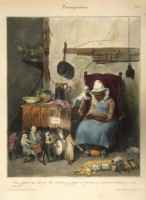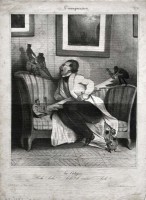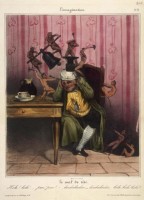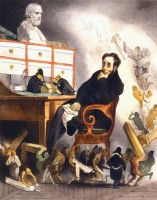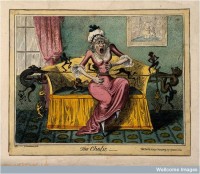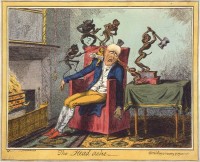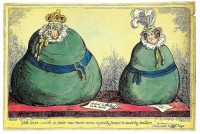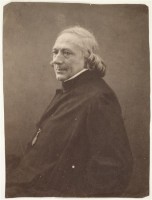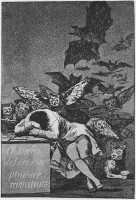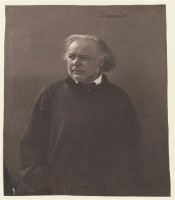The browser will either open the file, download it, or display a dialog.
Notwithstanding the relaxation of French censorship laws after the July Revolution, Honoré Daumier (1809–78) was condemned, in 1832, to a six-month prison term for the publication of the caricature Gargantua, portraying King Louis-Philippe (1773–1850) as Rabelais’s gluttonous giant.[1] On November 11, 1832, after two and a half months in the prison of Sainte-Pélagie, he was transferred for eleven weeks to Dr. J. P. Casimir Pinel’s (1800–66) mental hospital at rue Chaillot. There, far removed from the overcrowded and unhygienic prison, he labored on a series of drawings and watercolors titled L’Imagination, until his release on February 22, 1833.[2] The young printmaker Charles Ramelet (1805–51) made lithographs after Daumier’s sketches, and these started to appear in the press even before the artist had completed his sentence. The first print, published on January 14, 1833 in the new illustrated daily newspaper Le Charivari, depicted an old women daydreaming about inexhaustible wealth (fig. 1). It was accompanied by a short explanation by the editor Charles Philipon (1800–61), Daumier’s publisher, friend, and colleague, stating that the series sought to investigate “diabolic actions, castles in Spain, projects, desires, fixed ideas, and all the chimeras of the imagination.”[3]
Philipon’s explanation of the L’Imagination series is somewhat reminiscent of Francisco Goya’s (1746–1828) text to advertise his print series Los Caprichos, published in 1799. In these eighty aquatint etchings, Goya portrayed, as he stated in his text, “the innumerable foibles and follies to be found in any civilized society and from the common prejudices and deceitful practices which custom, ignorance, or self-interest have made usual . . . and which, at the same time, stimulate the artist’s imagination.”[4] Copies of Los Caprichos were owned by the end of the first quarter of the century by French collectors, artists, lithographers, and printmakers, and, as of 1827, became available to the general public at the Bibliothèque Nationale.[5] Starting in the 1830s, these prints exerted their influence on English and French artists alike, among them, Daumier,[6] who, in Robert Hughes’s words about Goya, was “a merciless critic of the society around him and a habitual protester against war, cruelty, and the violence of unjust authority.”[7]
In all fifteen prints, Daumier depicted men, women, and children of various social classes, whose fantasies regarding success, a warm bed, going fishing, having plenty of toys, or committing suicide, are given form by means of miniature figures that act them out. Yet, two of the images differ from the rest of the series: The Colic (La Colique), the sixth print, published in Le Charivari on February 19, 1833 (fig. 2), and The Headache (Le Mal de tête), the ninth print, published some two months later on April 23, 1833 in the same journal (fig. 3). Despite their pictorial resemblance to the rest of the lithographs in L’Imagination—all depicting a main figure surrounded by a series of miniature figures—they do not depict hidden passions, daydreams, fantasies, or secret desires. Instead, The Colic and The Headache depict the suffering of the body, as indicated by their distinctive titles.
This article addresses the singularity of The Colic and The Headache within the Imagination series. Based on Jean Cherpin’s identification of the man suffering the stomachache as Philipon,[8] I will argue that The Colic and The Headache are, in fact, symbolic portraits of the choleric publisher and the melancholic painter during their joint incarceration in Casimir Pinel’s Parisian maison de santé. Comparing the prints with two caricatures by George Cruikshank (1792–1878) that, I argue, served as their direct source of inspiration, I will show that it is precisely the differences between the two pairs of prints that are significant. Specifically, the lack of a visual depiction, in Daumier’s prints, of the causes of the pain of his protagonists and of the possibility of a cure, seems to turn this pain into a socio-psychological symptom caused by censorship and suppression.
Dr. Casimir Pinel and His Clinic
Before discussing The Colic and The Headache in more depth, it is important to focus on the clinic in which they were produced and on the man who ran it. Dr. Pinel, whose portrait, according to Cherpin, was part of the L’Imagination series, in which he has the role of The Doctor (Le Médecin),[9] was published in Le Charivari on August 19, 1833 (fig. 4). It represents the physician seated in a pensive, melancholic pose under the classical sculpted portrait of Hippocrates. Above the doctor’s head, the image of death holding a sickle is guiding a group of demons who enthusiastically carry away his deceased patients. On his desk, two demons are building an additional coffin for their next victim. “Why the heck are all my patients leaving?,” he ponders. “I bleed them, treat them and drug them. . . . I simply do not understand.”[10] The caption appears to ridicule the limited knowledge of physicians, as frequently illustrated by Daumier during the 1830s and 1840s, and to demonstrate the inadequacy of medical methods, ranging from the relatively merciful administration of opiates to more aggressive approaches, such as bloodletting or starvation.[11] Yet, both the artist, who produced the caricature, and Philipon, who added the caption, knew that Dr. Pinel’s approaches were far from inadequate and, as we’ll see in the following, the print as well as its caption invite another reading as well.[12]
Dr. Casimir Pinel was the nephew of the famous Philippe Pinel (1745–1826), who was among the early nineteenth-century physicians who revolutionized the approach to mental disorders, viewing “madness” as an illness that requires care, compassion, and understanding.[13] As one of the founders of the “moral treatment” approach,[14] Philippe Pinel argued that psychological intervention must be grounded in an understanding of the patient’s own perspective and history. He dramatically improved asylum conditions, while insisting on psychological therapeutic approaches.[15] Following in the footsteps of his famous uncle,[16] in 1829 Casimir Pinel rented a house with a large garden at 76, rue de Chaillot, to serve as a mental health center. Spacious, comfortable, and filled with air and light, reflecting his progressive medical methods, Pinel’s clinic provided repose and personalized attention for a limited number of affluent mental patients.[17] He also received notorious political prisoners from Sainte-Pélagie, who had obtained permission to be transferred to his mental health center for reasons of poor health.[18]
On November 10, 1832, Philipon, who had been convicted, like Daumier, of contempt of the king’s person and sentenced in January 1832 to a large fine and a thirteen-month incarceration at Sainte-Pélagie, was sent for the second time to Pinel’s sanatorium.[19] The same day, the doctor received a letter from the Préfet de Police announcing the transfer of Daumier to his sanatorium. “Daumier, whose transfer was authorized by the minister of the interior, must be kept in detention, and Dr. Pinel is ordered not to let him leave his establishment under any circumstance. By accepting Daumier, Dr. Pinel becomes responsible for the prisoner . . . under the penalties set out by law.”[20] The letter from the Préfet was similar to those Pinel received for other political prisoners, none of which affected the open-minded doctor’s amicable conduct toward his patients.[21] Overtly known as a liberal, he turned a blind eye to his political prisoners’ pursuit of their subversive activities from within the clinic.[22] Indeed, after the harshly repressed rebellion following General Jean Maximilien Lamarque’s (1770–1832) funeral on June 5, 1832, a group of Parisian policemen accompanied by a troop of infantrymen invaded Pinel’s establishment in search of Charles Philipon and another political journalist, both adversaries of the newly established July Monarchy. Having failed to find Philipon, the policemen accused Pinel of not having taken care of his charge and he was obliged to pay a fine.[23]
These circumstances shed a different light on Pinel’s portrayal in Daumier’s print. As the good doctor is wondering why his patients are leaving him, he is not pondering his own inadequacy or that of his medicines; he is questioning the police brutality forced upon the political prisoners remanded to his care, as indicated by the policemen building a coffin on the doctor’s desk, as well as by the officer leading the row of cadavers at his feet.[24]
From Comedy to Satire: Daumier and Cruikshank
The work on the humoristic and apolitical L’Imagination series at the time of his confinement at the hospital may have offered Daumier some comic relief, distancing him from the political caricatures that had led to his imprisonment. On October 8, 1832, while he was incarcerated at Sainte-Pélagie, Daumier wrote to his friend, the artist Philippe-Auguste Jeanron (1808–77): “Don’t talk politics, because letters are unsealed.”[25] Clearly, this was not the time for explicit political caricatures or portraits-charge. But Daumier did not entirely stay away from socio-political criticism, as his print The Doctor and his two prints The Headache and The Colic show. Indeed, just as the first print comments on the actions of the police in Pinel’s establishment, so the latter comment on the effects of those actions on some of the clinic’s patients.
The uniqueness of The Headache and The Colic may be explained by their source of inspiration: two lithographs made in 1819 by the English caricaturist and illustrator George Cruikshank, depicting a woman experiencing a stomachache and a man suffering from a headache (figs. 5, 6).[26] Daumier borrowed not only the concepts and compositions of the two prints, but also their titles.
Despite the ongoing rivalry between the French and the English, which intensified from the outbreak of the French Revolution and manifested itself, among other ways, in a mutual caricature war promoted by the establishment,[27] the artistic links between the two neighboring nations continued to flourish throughout the nineteenth century.[28] This trend grew after the Battle of Waterloo of 1815, when some 30,000 English tourists visited France. They brought with them a plethora of British caricatures and prints, which quickly became fashionable among the liberal French middle classes that considered England a political model worth emulating.[29] The abundant imports of English prints also influenced the French caricaturists, among them Daumier. They were impressed by the relative liberty enjoyed by their colleagues across the channel, who were not subjected to the rigid censorship laws of 1835, implemented in France until 1881.[30]
Philipon may have been influenced by Cruikshank when he drew his famous Les Poires, a caricature portrait of Louis Philippe, in 1831. The print echoes an 1820 caricature produced by Cruikshank depicting King George IV (1772–1830) and his wife Caroline (1768–1821) as two pear-shaped green sacs (fig. 7).[31] By juxtaposing the queen’s seductive gaze with the king’s disdainful look, the artist alluded to the overflowing bag of evidence of the queen’s unfaithfulness, evidence which the king—who wished to divorce her, to his citizens’ discontent—had caused to be gathered.[32] Despite the fact that Philipon was sentenced to six months imprisonment and a large fine, the pear subsequently appeared all over Paris, and became the image commonly associated with the king in the works of caricaturists, including Daumier’s Gargantua, executed in December of the same year.[33]
Whether Daumier was introduced to Cruikshank by Philipon or whether he discovered his prints independently, there is no doubt that Daumier was familiar with The Colic and The Headache, as demonstrated by their affinity to the prints he created over a decade later as part of the L’Imagination series. Daumier’s deliberate use of British caricatures may be seen as a form of covert social criticism, akin to William Hogarth’s (1697–1764) deliberate use of the French style in his anti-British satirical series Marriage à-la-mode, painted between 1743 and 1745. Much like Hogarth’s “unremitting attack on the absorption by the social elite of . . . French . . . cultural values and lifestyle . . . that has infected and weakened British identity,”[34] so too did Daumier satirize French society by replicating English caricatures.
In The Colic, Daumier transformed Cruikshank’s elderly woman into a suffering, middle-class man, whom Cherpin has identified as Philipon (fig. 8). In his lithograph (fig. 5), the British caricaturist suggests that the stomachache is caused by the wearing of a tight-laced corset, represented in the print by demons tightening a rope around the woman’s waist, while one of their friends attacks her with a needle, designated to stitch the back of her dress in order to make her figure as slender as possible. Unlike the corpulent woman in the painting on the wall to the right, standing in her bedroom, drinking a glass of liquor—a popular remedy for abdominal pain[35]—the agonies of the scrawny woman in the foreground are self-inflicted, reflecting her submission to the strains of fashion.
Despite the obvious similarities, Daumier refrained from illustrating the causes of the stomachache, and chose, rather, to focus on a visual depiction of the pain itself by means of demons gleefully sawing the throbbing innards of the agonized man. Thus, by omitting the patient’s responsibility for his pain, he completely altered the viewer’s attitude toward the patient, who is no longer to blame for his own suffering.
The same modification is apparent in Daumier’s depiction of the headache. While Cruikshank emphasized its cause by means of two voluminous books on the table next to the patient (fig. 6), Daumier avoided any reference to the patient’s responsibility for his own affliction. He also omitted the remedy in the patient’s hand in Cruikshank’s image. While Cruikshank illustrated specific illnesses, with graspable causes, and hence possible remedies, Daumier converted the colic and the headache to mere symptoms, whose origins are unidentified. By eliminating the causes of the pain as well as potential cures (loosening the corset, drinking some painkilling medicine), he implied that the cause of pain is in fact psychological or social rather than corporeal.
Pain as Resistance
In addition to Cruikshank’s print, another source of inspiration for Daumier’s The Headache may have been Goya’s etching, The Sleep of Reason Produces Monsters from the series Los Caprichos, a portrait of the artist who has fallen asleep at his drawing table and is surrounded by owls and bats (fig. 9).[36] “The author dreaming,” inscribed Goya in pencil at the bottom of the preparatory sketch. “His only purpose is to banish harmful ideas commonly believed, and to perpetuate with this work of the Caprichos the solid testimony of truth.”[37]
Daumier possibly was referencing Goya when he altered Cruikshank’s figure into a cross-legged man sitting at a desk partly cropped by the picture frame, leaning to the right with his hands placed on either side of his head, surrounded by demonic creatures.
Indeed, like The Sleep of Reason Produces Monsters, Daumier’s Headache may be a self-portrait, as the likeness with contemporary photographs of Daumier suggests (fig. 10). If this is the case, we may interpret The Headache not as an amusing caricature in Cruikshank’s style, but as a political and social commentary in a period of disillusionment with Louis-Philippe’s new regime.
Instead of producing explicit political caricatures, Daumier used what Richard Terdiman has called a “counter-discursive” strategy as a means of resistance. This strategy was developed in Le Charivari, founded by Philipon and Daumier during their mutual imprisonment in Dr. Pinel’s mental hospital. Le Charivari, according to Terdiman, “opened a space for important forms of cultural resistance to the dominant discourses of nineteenth century liberal capitalism”[38] and was intended for readers whose social perspective alienated them from the official stances. Daumier depicted their suffering and its physical implications.
Since antiquity, connections had been made between mind and body. This connection was best exemplified by Hippocrates’s theory of four humors, in which an excess of a body fluid (blood, phlegm, black bile, or yellow bile) was thought to determine a person’s temperament. In their analysis of Albrecht Dürer’s famous print Melencolia I (1514), Erwin Panofsky and Fritz Saxl showed that by the late Middle Ages, typologies had developed of these four temperaments—the choleric, the melancholic, the phlegmatic, and the sanguinic. These typologies, particularly the one for melancholy—commonly presented as a seated figure, legs crossed and head resting on one of the hands—continued well into the nineteenth century, as confirmed by Dr. Pinel in a book dealing with mental disorders.[39] Imagination became increasingly identified with artistic power, genius, and originality; melancholy had come to be connected not merely with sadness, dejection, and despondency, but also with creative genius and intellect.[40] Daumier’s The Headache corresponds to the typology of melancholy, just as The Colic may be associated with the choleric temperament, as “cholera” originates in the Greek word for “bile” and was regarded as an excess of black bile, generating melancholy and depression, directly linked to artistic creation.[41]
In The Body in Pain, Elaine Scarry links pain to the act of imagining.[42] Faced with the difficulty of expressing pain, sufferers must resort to the imagination: “It feels as if . . . ”[43] Both prints may be seen as the results of such imagining in their depiction of devils torturing their victims with various instruments of torture. David Morris has argued that, through the link between demons and pain, nineteenth-century artists, among them Cruikshank and Daumier, expressed the popular belief that “almost any affliction from headache to insanity might be attributed to the influx of demons sent by the enemy,” and that they served as a punishment for the “violation of a tribal taboo.”[44] Yet, unlike the grotesque, amusing demons of his English counterparts, Daumier’s demons are represented as men with human bodies, with the exception of their tails and horns that attest to their demonic nature. It appears that, unlike Cruickshank, Daumier focused on the pain inflicted by fellow men who have metamorphosed into demons.
Daumier’s use of pain as a tactic of protest against established strategies are further illuminated by the arguments of the political scientist James Scott, who argues in his book Domination and the Art of Resistance that illness is a kind of “hidden transcript” that represents a critique of power spoken behind the backs of the dominant.[45] Illness serves the members of the subordinate classes to achieve respite from their labor, stop functioning, refrain from collaborating with those in power, and resist their authority. Illness permits patients to criticize without taking responsibility for their criticism, and to obtain empathy and forgiveness from their entourage for their subversive position.[46]
Though Arthur Kleinman agrees with Scott that illness can become a physical act of defiance and disobedience, he argues that the protest by means of pain comes at a significant cost to the protesters, who endanger their jobs, their status, and their property. Kleinman therefore claims that, in the end, the patients are ineffective as protesters. As heroic as they may seem to the observer, they have gained neither empowerment nor additional meaning, and the chronic pain constitutes degenerative paralysis for them, a cause of despair and self-destruction.[47]
In conclusion, Daumier’s The Colic and The Headache embed physical pain with socio-psychological torments of the soul, reflecting oppression and censorship. Yet, both prints simultaneously initiate social criticism, offering mental cathartic relief to the oppressed artist through artistic realization. If arrest and detention is within the jurisdiction of the powerful, then headaches, stomachaches, and melancholy are the humble protest of the weak, their last resort, preventing them from taking part in their own daily exploitation.
I am tremendously grateful to Dr. Guy Tal for his insightful comments. Special thanks to Prof. Petra ten-Doesschate Chu for her helpful suggestions on various drafts of this essay.
All translations are by the author unless otherwise indicated.
[1] Honoré Daumier, Gargantua, lithograph, La Caricature, December 16, 1831. For an analysis of this caricature, see Elizabeth C. Childs, “Big Trouble: Daumier, Gargantua, and the Censorship of Political Caricature,” Art Journal 51, no. 1 (Spring 1992): 26–37, doi:10.2307/777251[login required].
[2] Nicolas-Auguste Hazard and Loÿs Delteil, Catalogue raisonné de l’oeuvre lithographié de Honoré Daumier (Oise: N.A. Hazard, 1904), 427–30, plates 1978–92, accessed July 20, 2017, https://archive.org/stream/gri_33125007982206#page/n7/mode/2up/search/imagination; Shao-Chien Tseng, “Honoré Daumier’s l’Imagination Series,” Oculus, Journal for the History of Art 1, no 1 (1998), 72–79; and Colta Ives, Margret Stuffmann, and Martin Sonnabend, Daumier’s Drawings, exh. cat. (New York: The Metropolitan Museum of Art, 1993), 253.
[3] “les actions diaboliques, les châteaux en Espagne, les projets, les souhaits, les idées fixes, toutes les chimères de l’imagination.” Le Charivari, January 14, 1833, 3.
[4] Diario de Madrid, February 6, 1799, 149, cited in Nigel Glendinning, Goya and His Critics (New Haven: Yale University Press, 1977), 49. Goya’s description of the series was well known in France. Valentin Carderera, “François Goya,” Gazette des beaux-arts 15, no. 3 (September 1863): 240.
[5] Théophile Gautier, “Francisco Goya y Lucientes,” Le Cabinet de l’amateur et de l’antiquaire: Revue des tableaux et des estampes anciennes, des objets d’art, d’antiquité et de curiosité (Paris: Bureau du Journal, 1842): 1:339–40, 343–44; Carderera, “François Goya,” 240; Michel Florisoone, “Comment Delacroix a-t-il connu les ‘Caprices’ de Goya?,” Bulletin de la Société de l’Histoire de l’Art Français (1957): 131–44; Paul Guinard, “Romantiques Français en Espagne,” in Art de France: Études et chroniques sur l’art ancien et moderne, ed. Pierre Berès et André Chastel (Paris: Hermann, 1962), 2:179–206; Nina Maria Athanassoglou-Kallmeyer, Eugène Delacroix: Politics and Satire, 1814–1822 (New Haven: Yale University Press, 1991), 96–97; Ilse Hempel Lipschutz, Spanish Painting and the French Romantics (Cambridge, MA: Harvard University Press, 1972), 68; and Paul Guinard, “Baudelaire, le Musée espagnol et Goya,” Revue d’Histoire littéraire de la France 67, no. 2 (April–June, 1967): 323n4.
[6] From 1831 to the early 1850s, Daumier was also influenced by other prints from Goya’s Caprichos series. For an elaboration on this subject, see Reva Wolf, Goya and the Satirical Print in England and the Continent, 1730 to 1850 (Boston: David R. Godine, 1991), 20, 35, 46, 63–64.
[7] Robert Hughes, Goya (New York: Knopf, 2003), 47.
[8] Jean Cherpin, Daumier et la Sculpture (Paris: Éditions de La Revue Moderne, 1979), 77–78.
[9] Ibid.
[10] “Pourquoi, diable! mes malades s’en vont ils donc tous? . . . . . . . . . . . . j’ai beau les soigner, les purger, les droguer, . . . . . . . . . . . . je n’y comprends rien!”
[11] See, for example, Honoré Daumier, First bleed, next purge, then use the clyster (Primo saignare, deinde purgare, postea clysterium donare), lithography, published in La Caricature, December 5, 1833, The Daumier Register, accessed July 20, http://www.daumier-register.org/werkview.php?key=73; Honoré Daumier, The Recipe to cure colic (Recette pour guérir la colique), lithography, published in Le Charivari, January 14, 1838, The Daumier Register, accessed July 20, http://www.daumier-register.org/werkview.php?key=427 ; Honoré Daumier, The Doctor and the Nurse (Le Médecin et la garde malade), from the series Emotions Parisiennes, no. 40, lithography, published in Le Charivari, July 4, 1840, The Daumier Register, accessed July 20, http://www.daumier-register.org/werkview.php?key=714.
[12] Cherpin, Daumier et la Sculpture, 48; Tseng, “Honoré Daumier’s l’Imagination Series,” 73–75. In a letter written to his mother in April 1834 from Pinel’s clinic, the imprisoned journalist Ferdinand Bascans wrote: “Mr Pinel, the director of the maison de santé, is an excellent man, good, warmhearted, who wishes to give me all the latitude possible.” Quoted in Georges d’Heylli, ed., La Fille de George Sand: Lettres inédites publiées et commentées (Paris: Imprimerie de A. Davy, 1900), 132. Similar appraisals were delivered in a text titled “Maison de santé du Docteur Pinel, Rue de Chaillot, No 76,” published in La Caricature, August 8, 1833, 1152.
[13] Ian R. Dowbiggin, Inheriting Madness: Professionalization and Psychiatric Knowledge in Nineteenth-Century France (Berkeley: University of California Press, 1991), 11–12, 19–21; Jan E. Goldstein, Console and Classify: The French Psychiatric Profession in the Nineteenth Century (Chicago: University of Chicago Press, 2002), 152–58; Robert Castel, The Regulation of Madness: The Origins of Incarceration in France, trans. W. D. Halls (Berkeley: University of California Press, 1988), 214–18.
[14] “Moral treatment” is an approach to mental disorder based on humane psychosocial care or moral discipline that emerged in the late eighteenth century and came to the forefront during the nineteenth-century, during the reform of the asylum system in Western Europe. For further information see: Dorothy Miller and Esther Blanc, “Concepts of ‘Moral Treatment’ for the Mentally Ill: Implications for Social Work with Posthospital Mental Patients,” Social Service Review 41, no. 1 (March, 1967): 66–74; and Donald L. Gerard, “Chiarugi and Pinel Considered: Soul’s Brain/Person’s Mind,” Journal of the History of the Behavioral Sciences 33, no. 4 (September, 1997): 381–403.
[15] Dora B. Weiner, “The Apprenticeship of Philippe Pinel: A New Document, ‘Observations of Citizen Pussin on the Insane,’” American Journal of Psychiatry 136, no. 9 (September 1979): 1128–34; George H. Pollock, “The Regulation of Madness: The Origins of Incarceration in France,” American Journal of Psychiatry 146, no. 12 (December 1989): 1631–32; Gerard, “Chiarugi and Pinel Considered,” 381–403; and Annie Borthwick and others, “The Relevance of Moral Treatment to Contemporary Mental Health Care,” Journal of Mental Health 10, no. 4 (2001): 427–39, doi:10.1080/09638230124277.
[16] In 1860, Casimir Pinel published a biography of his uncle. Casimir Pinel, “Pinel: A Biographical Study,” Journal of Psychological Medicine and Mental Pathology 13 (1860): 184–205.
[17] “Maison de santé du Docteur Pinel,” 1152; D’Heylli, La Fille de George Sand, 132; René Semelaigne, Aliénistes et philanthropes: Les Pinel et les Tuke (Paris: G. Steinheil, 1912), 270–73; and Elizabeth K. Menon, “Philipon, Dr. Pinel, Ste. Pélagie, and La caricature,” Source 14, no. 1 (Fall 1994): 32–38.
[18] “Maison de santé du Docteur Pinel,” 1152; René Semelainge, “Une maison de santé sous la monarchie de juillet,” La Chronique médicale 18, no. 12 (June 15, 1911): 369–71; and Émile Gilbrin, “La lignée médicale des Pinel, Leur aide aux prisonniers politiques sous la Terreur et pendant la Restauration,” Histoire des sciences médicales 11, nos. 1–2 (1977): 29–35.
[19] Henry Loyrette, Daumier: 1808–1879, exh. cat. (Ottawa: Musée des Beaux-Arts du Canada, 2000), 547.
[20] “Le dit Daumier dont la translation a été consentie par le Ministre de l’Intérieur, devra être tenu en état de détention, et il sera enjoint au Dr. Pinel de ne le laisser sortir de son établissement sous quelque prétexte que ce soit. En recevant le dit Daumier, le Dr. Pinel devient responsable de la personne de ce condamné . . . sous les peines prévues par la Loi.” The original letter appears in Semelainge, “Une maison de santé,” 377.
[21] Ibid., 372–76.
[22] Ibid., Gilbrin, “La lignée médicale des Pinel,” 33.
[23] Semelainge, “Une maison de santé,” 372–76; Gilbrin, “La lignée médicale des Pinel,” 33; Paul Janet, “Le Globe de la restauration et Paul-François Dubois,” Revue des deux mondes 34 (1879): 481–512; and Jean Cherpin, André Negis, and Louis Sergent, “De la maison de santé a l’imagination,” Æsculape (March 1959), 44–51.
[24] Tseng, “Honoré Daumier’s l’Imagination Series,” 74–75.
[25] Quoted in Arsène Alexandre, Honoré Daumier: L’homme et l’œuvre (Paris: H. Laurens, 1888), 54–55.
[26] Richard A. Vogler, ed., Graphic Works of George Cruikshank (London: Dover, 1979), 135. Both of Cruikshank’s caricatures are based on the drawings of Captain Frederick Marryat, a naval officer, author, and illustrator, and one of Cruikshank’s most productive partners at the end of the first decade of the nineteenth century and throughout the 1820s. Robert L. Pattern, George Cruikshank’s Life, Time and Art (New Jersey: Rutgers University Press, 1992), 194–96). A miniature drawing of an anchor with the inscription “Marryat del., G. Cruikshank fect.” appears on Cruikshank’s original print, meaning that Marryat conceived the idea (del = passed) and Cruikshank produced the print (fect = make). See Vogler, Graphic Works of George Cruikshank, 133.
[27] Athanassoglou-Kallmeyer, Eugène Delacroix: Politics and Satire, 1–3.
[28] For a discussion of the influence of English art on French art from 1820 to 1840, see Patrick Noon, Crossing the Channel: British and French Painting in the Age of Romanticism, exh. cat. (London: Tate Britain, 2003); and Edward Morris, French Art in Nineteenth-Century Britain (New Haven: Yale University Press, 2005), chaps. 4–5.
[29] Athanassoglou-Kallmeyer, Eugène Delacroix: Politics and Satire, 2–3, 24–25, 98–99; Roger André, L’Occupation de la France par les alliés en 1815 (Paris: E. de Boccard, 1924), 124–25, 139–42; and Wolf, Goya and the Satirical Print, 11–12.
[30] Robert Justin Goldstein, “The Debate over Censorship of Caricature in Nineteenth-Century France,” Art Journal 48, no. 1 (Spring 1989): 12, http://www.tandfonline.com/doi/abs/10.1080/00043249.1989.10792581. For Cruikshank’s influence on Daumier, see Elizabeth C. Childs, Daumier and Exoticism: Satirizing the French and the Foreign (New York: Peter Lang, 2004), 129; Francis Donald Klingender, ed., Hogarth and English Caricature (London: Curwen Press, 1944), vii; and Kevin Williams, Read All About It!: The History of the British Newspaper (Oxford: Routledge, 2010), 14, 93.
[31] For further discussion, see Song-Yi Lee, “Queen Caroline and the Popular Response: The Politics of Addresses and the Hidden Language of Liberty,” Foundations 4, no. 1 (Fall 2009): 99–142.
[32] Pattern, George Cruikshank’s Life, 171. For the English influence on Philipon, see James Cuno, “Charles Philipon, La Maison Aubert, and the Business of Caricature in Paris, 1829–1841,” Art Journal 43, no. 4 (Winter 1983): 354n19; and Michael Wynn Jones, George Cruikshank: His Life and London (London: Macmillan, 1978), 23–32.
[33] Childs, “Big Trouble,” 33–35. Klingender compares Cruikshank’s print Coronation (1820) to one of Daumier’s lithographs, published in Le Charivari, September 7, 1834. Klingender, Hogarth and English Caricature, 22.
[34] Mark Hallett and Christine Riding, Hogarth, exh. cat. (London, Tate Britain, 2006), 142. Hogarth employed three experienced French engravers for Marriage a-la-mode, who specialized in the French Academic style. He acknowledged their work fully by publishing his commissioned engravers’ names under each plate. Robert L. S. Cowley, Marriage a-la-mode: A Re-view of Hogarth’s Narrative Art (Manchester: Manchester University Press, 1983), 8–11; and Robin Simon, Hogarth, France and British Art (Cornwall: Hogarth Arts, 2007), 9–68.
[35] Everard Home, “Anti-Cholera Brandy,” London Medical Gazette: Medicine and the Collateral Sciences 10 (September 8, 1832): 741.
[36] The Sleep of Reason Produces Monsters was initially intended to be the first in the series originally called Sueños—dreams—and finally ended up at the beginning of the second part of the series dealing with superstitions and sorcery. John J. Ciofalo, “Goya’s Enlightenment Protagonist: A Quixotic Dreamer of Reason,” Eighteenth-Century Studies 30, no. 4 (Summer 1997): 430.
[37] Cited in Pierre Gassier and Juliet Wilson, The Life and Complete Work of Francisco Goya (New York: Harrison House, 1981), 163n537.
[38] Richard Terdiman, Discourse/Counter-Discourse: The Theory and Practice of Symbolic Resistance in Nineteenth-Century France (Ithaca: Cornell University Press, 1985), 160.
[39] Casimir Pinel, De la Monomanie, considérée sous le rapport psychologique, médical et légal (Paris: Labé, 1856), 3–4.
[40] Jennifer Radden, “Is This Dame Melancholy?: Equating Today’s Depression and Past Melancholia,”Philosophy, Psychiatry, & Psychology 10, no. 1 (March 2003): 37–52, doi:10.1353/ppp.2003.0081 [login required]; Piers Britton, “‘Mio malinchonico, o vero, mio pazzo’: Michelangelo, Vasari, and the Problem of Artists’ Melancholy in Sixteenth-Century Italy,” Sixteenth Century Journal 34, no. 3 (Fall 2003): 653–75; and Stanley W. Jackson, Melancholia and Depression: From Hippocratic Times to Modern Times (New Haven: Yale University Press, 1986), viii-x.
[41] Juhani Norri, Dictionary of Medical Vocabulary in English, 1375–1550: Body Parts, Sicknesses, Instruments, and Medicinal Preparations (London: Routledge, 2016), 200; and Richard Saunders, The Astrological Judgement and Practice of Physick (1677; repr., Abingdon, MD: Astrology Classics, 2003), 162.
[42] Elaine Scarry, The Body in Pain: The Making and Unmaking of the World (New York: Oxford University Press, 1985), 162.
[43] Ibid., 15–22.
[44] David Morris, The Culture of Pain (New Haven: Yale University Press, 1993), 45–46.
[45] James C. Scott, Domination and the Art of Resistance (New Haven: Yale University Press, 1990), xii.
[46] Ibid., 140–41.
[47] Arthur Kleinman, “Pain and Resistance: The Delegitimation and Relegitimation of Local Worlds,” in Pain as Human Experience: An Anthropological Perspective, ed. Mary-Jo DelVecchio Good and others (Berkeley: University of California Press, 1992), 173–75.


